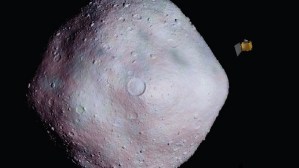This NASA artist’s concept shows the OSIRIS-REx spacecraft near asteroid 1999 RQ36 obtained on February 15, 2013. Every year, sensors designed to detect nuclear explosions see harmless bursts in Earth?s upper atmosphere from the breakup of an asteroid a few yards across. Tiny asteroids are much more numerous than big ones, so destructive hits to Earth are very rare. However, because of their potential for devastation, NASA’s Near-Earth Object (NEO) observations program supports surveys which are undertaking sustained searches to find the largest objects and predict their impact threat to Earth. According to NASA’s NEO program, there are more than 1,300 “Potentially Hazardous Asteroids” (PHAs) ? objects at least 150 yards (about 140 meters) across with a very small chance of impacting us someday because their orbital paths take them close to Earth’s orbit. =RESTRICTED TO EDITORIAL USE – MANDATORY CREDIT ” AFP PHOTO /NASA Goddard Space Flight Center /” – NO MARKETING NO ADVERTISING CAMPAIGNS – DISTRIBUTED AS A SERVICE TO CLIENTS =
US-SPACE-ASTRONOMY-ASTEROID
Lapatilla


